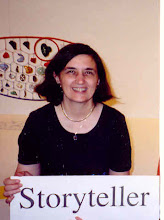As always, selecting stories is one of the key elements in preparing any type of program. My usual standards are to consider the theme for the program if there is one, the age of the participants and the possibilities for interaction, student /audience involvement. Working with the kids at CIS, I know that they come to the program in the afternoon after being in school all day so that their need to move is great. Even if some of the stories are a bit “young” for the older students in the crowd, all will understand, and the stories with a simpler storyline offer the widest latitude for student involvement.
Plus, the fact that the older students probably already know many of the elements of some of the tales or quickly learn the story and pick it up, empowers them greatly when it comes to re-telling the tales—they are more likely to add their own touches to it when it is something they “know” or learned through my telling.
So, my selection of stories for this project was made not only with thematic elements (even with adaptations) in mind but also with an eye to the wide age range that would be in the audience. The age range of the students in the after-school sites ranges from grade 1 through grade 5. I will actually begin to present stories starting at 4:00 p.m. each of the three afternoons I am there. The first part of the time, while they are still doing homework, I will work with the staff to get things ready for the performance and the craft. One of the sites selected (Southport) is small—about twenty students and the other is twice that size. We will start with the smaller site.
As I noted earlier, they will have spent all day sitting still when they meet with me—and even the first part of their time in the after-school program is devoted to doing homework so, the need for physical movement is great.
One of the more exciting things that the CIS Director, Kathy Smith and I decided is that we will film the performances so that the storytelling aspect of the program can be used at other sites as well.
Here is the program as we envision it for the smaller number of students in the first session which is scheduled for the Southport site.
Day 1
3:30 PM arrive at school and lay out crafts and materials with teachers.
4:00 PM Telling begins with the story, “The Power of Words” (students will participate with call and response)
Then I will tell the story, of “ Three Bill Goats Gruff”
I have planned lots of action for this familiar tale which will have a twist ending—the troll will not be butted off the bridge. Instead he will agree to live peacefully under the bridge without bothering travelers anymore. Goats agree to walk without making so much noise as they go over the bridge—art of compromise!
After the “show”, each student will receive materials to make three goat puppets and a troll puppet. Their puppets will be small—craft stick size, but each student will have an entire set.
While they are doing the crafts, the teller (me) will ask a series of questions based on some of the material about bullying, in fact, using questions from several of the books. Students will not have to answer individually. The use of the questions is more to get the students think about the various issues about bullying raised by the stories than to gather information about bullying in that school or to analyze how the students feel about the topic.
This program builds on the everyday good work done by the teachers and administrators in the schools and the fantastic staff at Communities in Schools –you can find out about other wonderful projects that CIS is doing by looking at their website: http://www.cisbrunswick.org/
Subscribe to:
Post Comments (Atom)

No comments:
Post a Comment